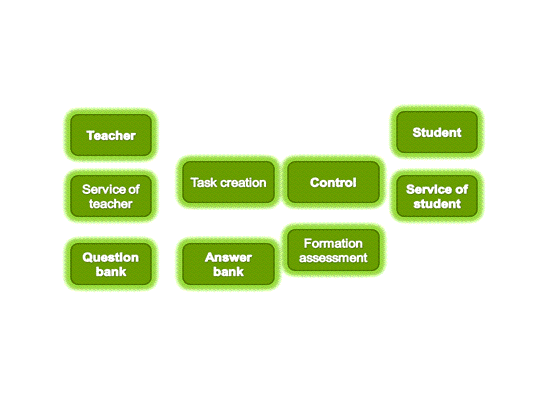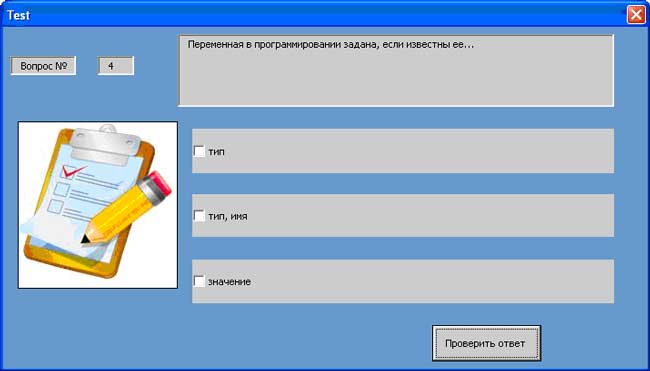

Abstract of master work:
Actuality
Under modern conditions of life one of the important factors in the successful transition of mankind from the post-industrial to an information society is the efficient education system functioning. University education is the primary component of the education system, which determines not only the present state of society, but also the prospects for its development.
Improving the educational process should be carried out according to various criteria. One of the main components of educational process modernization is objective methods of knowledge and quality assessment development. Knowledge quality control has three main functions:
1. Manages the learning process. Control allows you to determine the error, assess learning results, to correct knowledge and skills;
2. Educates cognitive motivation and stimulates creativity. Correctly organized control system allows to awaken a responsibility sense for learning results (getting a higher score), contributes to desire for devoted work to errors correction;
3. Is a learning and development means.
The problem of knowledge control is very difficult due to lack of rigorous knowledge structure. However, the most serious are the problems of objective knowledge evaluation. For example, the same assessment of the students' knowledge level in different educational institutions can comply with different knowledge levels. These problems can be successfully resolved by the testing using. Тesting has been widely used in the learning process, in the professional competence level determining. Advantages of knowledge evaluation by computer testing include:
1. Application of modern methods of knowledge assessment;
2. Efficiency of test results processing;
3. The possibility of implementing the training function;
4. Personalization of learning by students;
5. The release of teachers from performing routine work
Firstly, it is necessary to assess the quality of each test - compliance with the direction of the courses and real opportunities for students, taking into account the strong current time constraints on performance of test tasks. If a match toward course you can check by analyzing only the literature, then check "sustain-able" for each test, and even each job in a single test is possible only after checking in a real experiment.
Second, the desired evaluation of the applicability of all base tests, how it captures the entire program material, or at least the most important part.
The analysis of existing computer testing systems showed that they are mostly focused on testing, rather than on their development. In implementing the test none of the computer testing systems do not support adaptive tests.
Thus, the urgency of the matter is determined by the necessity to develop computer testing system that remove disadvantages of the considered systems, providing the implementation of adaptive testing.
The aim of the research work
The aim of the research work is to improve the control of knowledge by using computer testing system that enables timely receive information about the quality of the learning process necessary for making management measures.
To achieve the goal should be solved the following problem:
1. Analysis of existing computer systems, test and identify their advantages and disadvantages;
2. Analysis of existing models and algorithms for testing;
3. Finding ways to improve the quality of testing by using of a computer system testing;
4. Development of models and algorithms to improve the efficiency of using computer testing system;
5. Development of a computer testing system. Determination of its structure and functionality of its modules.
6. Testing of the developed system in a particular subject area.
Variety of tests and evaluation system
To create high-quality test material necessary to compile and include the different types assignment. For an objective evaluation of the degree of different types tests difficulty let input estimation coefficient r i.
1. One-alternative tests, sequences, open test tasks - tests with a clear choice answers. The following proposed evaluation system is called dichotomous.
ri = 1 [the correct answer / sequence]
ri = 0 [wrong answer / sequence]
2. Multi-alternative test (test with a multi-valued response). In response options can be more correct answer, but in different forms. In evaluating those tasks dichotomous assessment system is not sufficient. In this case it is necessary to consider not only the number of correct answers, but the number of errors.
 , где Q1 – Set all the correct answers in the task, Q2 – The number of correct answers selected by student, Q3 – Number of incorrect answers selected by student.
3. Task to establish correspondences
, где Q1 – Set all the correct answers in the task, Q2 – The number of correct answers selected by student, Q3 – Number of incorrect answers selected by student.
3. Task to establish correspondences
 , где Q1 – Amount of pairs for comparison, Q2 – Amount of correct pairings
4. Open test (table) When completing the table, each cell is a separate version of the answer. If one cell is filled incorrectly, the answer can not be counted as completely wrong (introduction of a false value in the cell may be a mechanical error, and therefore it should not completely clear the result of the work, but only to reduce the output of the task).
, где Q1 – Amount of pairs for comparison, Q2 – Amount of correct pairings
4. Open test (table) When completing the table, each cell is a separate version of the answer. If one cell is filled incorrectly, the answer can not be counted as completely wrong (introduction of a false value in the cell may be a mechanical error, and therefore it should not completely clear the result of the work, but only to reduce the output of the task).
 , где Q1 – The total number of cells, Q2 – The number of cells, which student selected correctly
5. Multistep test tasks (one-alternative, sequences) consists of a set of tasks (set of steps) that can be solved sequentially, where the transition to the next step of the task is carried out only after a correct answer to the previous step.
, где Q1 – The total number of cells, Q2 – The number of cells, which student selected correctly
5. Multistep test tasks (one-alternative, sequences) consists of a set of tasks (set of steps) that can be solved sequentially, where the transition to the next step of the task is carried out only after a correct answer to the previous step.
 , где i – Step number, mi – quantity of errors on the i-th step, n – quantity of steps
6. Multistep test (correspondence)
, где i – Step number, mi – quantity of errors on the i-th step, n – quantity of steps
6. Multistep test (correspondence)
 , где j – number of attempts to pass the step with an error, Q2ij – the number of pairs to produce the i-th step in the j-th attempt, Q1ij – the number of correct pairings on the i-th step in the j-th attempt.
7. Multi-step test (Multi-alternative)
, где j – number of attempts to pass the step with an error, Q2ij – the number of pairs to produce the i-th step in the j-th attempt, Q1ij – the number of correct pairings on the i-th step in the j-th attempt.
7. Multi-step test (Multi-alternative)
 , где Q1ij – the number of correct answers on the i-th step in an attempt to j, Q2ij – the number of correct answers selected by testing for the i-th step, Q3ij – the number of wrong answers, subjects were selected on the i-th step in the j-th attempt
Final performance of the test R, consisting of a set of test items containing Z levels of difficulty, determined by the formula:
, где Q1ij – the number of correct answers on the i-th step in an attempt to j, Q2ij – the number of correct answers selected by testing for the i-th step, Q3ij – the number of wrong answers, subjects were selected on the i-th step in the j-th attempt
Final performance of the test R, consisting of a set of test items containing Z levels of difficulty, determined by the formula:
 , где B – number of the points at the system, N – amount of tasks, zi – The level of the i-th task,
, где B – number of the points at the system, N – amount of tasks, zi – The level of the i-th task,  – The total complexity of the test, which is determined by the formula:
– The total complexity of the test, which is determined by the formula:
Structure of computer testing system

Figure 1 - Structure of computer testing system
15 frames. Animation size: 550px х 400px. File size: 35.7 Kbytes.
Created by Macromedia Flash.
At this point in the programming language Visual Basic the first version of the computer testing system is developed,
which includes a test editor. The base of tests consists of two types of questions: open test tasks and multi-alternative test tasks
Tasks are displayed one at a time so as not to detract from the proposed tasks (Fig. 2). If the student did not choose an answer,
he will see a warning message. At the end of testing on the screen shows the number of correct answers.

Figure 2 - Graphical user interface of computer testing system
Conclusions
Man in the modern conditions of life must have the possibility of continuous improvement of knowledge. With this purpose, constantly developing new learning technologies and implemented an effective form of knowledge control. One of these forms is testing. This is the most standardized and objective method of monitoring knowledge and skills evaluation.
There are methods of knowledge assessment using models that take into account only the correct responses of students, and models that take into account the parameters of tasks and level of learning.
The analysis of existing computer systems tested showed that they are mostly focused on testing, rather than on their development. In implementing the test none of the computer testing systems do not support adaptive tests.
Direction of future work is improving the base of test tasks. Addition other kinds of tasks, such as sequencing, assignment to establish compliance, multistage tests.
Literature
1. M.Bondarenko, V.Semenets, N.Belous, I.Kutsevich, I.Belous "Evaluation of tests of different types and determine their level of complexity," 2009, "Artificial Intelligence" / National Library of Ukraine. Vernadsky [electronic resource] - Access mode: http://www.nbuv.gov.ua/portal/natural/ii/2009_ 4 / 7% 5C00_Bondarenko_Semenets_Belous_Kutsevich_Belous.pdf
2. A.Pavolotsky "The methodology of the automated monitoring of knowledge." 2006. Moscow State Pedagogical University. [Electronic resource] - Access mode: http://conf2006.pskovedu.ru/files/thesis/388.doc
3. A.Proskurnin "Automated control system of knowledge" / Rostov State Pedagogical University [electronic resource] - Access mode: http://www.philippovich.ru/Projects/RFFI/almanah/Proskurnin1.pdf
4. M.Chelyshkova Theory and practice of designing pedagogical tests [Text] Chelyshkova M. - M.: Logos, 2002. - 432 pp.
5. Malcheva R., Korotin Y. & Gurov D. The applying of the computer visualization technology for improving of lectured perception. / / Proceedings of the VIII IRTC, V.3. Donetsk, 2001 - s.161-164.Malcheva R., Korotin Y. & Gurov D. The applying of the computer visualization technology for improving of lectured perception. / / Proceedings of the VIII IRTC, V.3. Donetsk, 2001 - s.161-164.
6. Andreev, S. Kaplan, V. Kinelev, G.Krasnov, V.Krivosheev. "Teaching on the Internet." Textbook. book / Ed. Editor VI Soldatkin. - M.: Higher School, 2003 - 792 sec.
7. Moses M., Polat E., Bukharkina M., Nezhurina M. Internet Learning: instructional design technology, Ed. kandidata Education Sciences MV Moses. - Moscow: Publishing House "Cameron", 2004. - 216.
8. Timkin S. An introductory course in information obrazovaelnuyu Wednesday Open Education (ILE GS): Manual. - Omsk: Omsk State University Publishing, 2005. - 136s.
9. Avanesov V. Foundations of the scientific organization of the pedagogical control in higher education. / Tutorial. M., 1989. - 167s.
10. Avanesov B.C. Scientific problems test knowledge control / Manual. M., 1994. - 135.
11. K.Gurevich, Testing methods in teaching research: Methods of Educational Research. M., 1979. S. 139 - 158.
12. H.Matushansky Design pedagogical tests for knowledge control / / Computers & Education. - 2000. - № 6. - S. 7-10.
13. P.Kline Handbook on designing tests, Ed. from English. - K.: PAS Ltd, 1994.. - 288.
14. O.Vorobeychikova Structured tests as a means of controlling knowledge / Computer science and education. - 2001. - № 7. - P.14-17.
 , где Q1 – Set all the correct answers in the task, Q2 – The number of correct answers selected by student, Q3 – Number of incorrect answers selected by student.
, где Q1 – Set all the correct answers in the task, Q2 – The number of correct answers selected by student, Q3 – Number of incorrect answers selected by student.
 , где Q1 – Amount of pairs for comparison, Q2 – Amount of correct pairings
, где Q1 – Amount of pairs for comparison, Q2 – Amount of correct pairings
 , где Q1 – The total number of cells, Q2 – The number of cells, which student selected correctly
, где Q1 – The total number of cells, Q2 – The number of cells, which student selected correctly
 , где i – Step number, mi – quantity of errors on the i-th step, n – quantity of steps
, где i – Step number, mi – quantity of errors on the i-th step, n – quantity of steps
 , где j – number of attempts to pass the step with an error, Q2ij – the number of pairs to produce the i-th step in the j-th attempt, Q1ij – the number of correct pairings on the i-th step in the j-th attempt.
, где j – number of attempts to pass the step with an error, Q2ij – the number of pairs to produce the i-th step in the j-th attempt, Q1ij – the number of correct pairings on the i-th step in the j-th attempt.
 , где Q1ij – the number of correct answers on the i-th step in an attempt to j, Q2ij – the number of correct answers selected by testing for the i-th step, Q3ij – the number of wrong answers, subjects were selected on the i-th step in the j-th attempt
, где Q1ij – the number of correct answers on the i-th step in an attempt to j, Q2ij – the number of correct answers selected by testing for the i-th step, Q3ij – the number of wrong answers, subjects were selected on the i-th step in the j-th attempt
 , где B – number of the points at the system, N – amount of tasks, zi – The level of the i-th task,
, где B – number of the points at the system, N – amount of tasks, zi – The level of the i-th task,  – The total complexity of the test, which is determined by the formula:
– The total complexity of the test, which is determined by the formula:


1. M.Bondarenko, V.Semenets, N.Belous, I.Kutsevich, I.Belous "Evaluation of tests of different types and determine their level of complexity," 2009, "Artificial Intelligence" / National Library of Ukraine. Vernadsky [electronic resource] - Access mode: http://www.nbuv.gov.ua/portal/natural/ii/2009_ 4 / 7% 5C00_Bondarenko_Semenets_Belous_Kutsevich_Belous.pdf 2. A.Pavolotsky "The methodology of the automated monitoring of knowledge." 2006. Moscow State Pedagogical University. [Electronic resource] - Access mode: http://conf2006.pskovedu.ru/files/thesis/388.doc 3. A.Proskurnin "Automated control system of knowledge" / Rostov State Pedagogical University [electronic resource] - Access mode: http://www.philippovich.ru/Projects/RFFI/almanah/Proskurnin1.pdf 4. M.Chelyshkova Theory and practice of designing pedagogical tests [Text] Chelyshkova M. - M.: Logos, 2002. - 432 pp. 5. Malcheva R., Korotin Y. & Gurov D. The applying of the computer visualization technology for improving of lectured perception. / / Proceedings of the VIII IRTC, V.3. Donetsk, 2001 - s.161-164.Malcheva R., Korotin Y. & Gurov D. The applying of the computer visualization technology for improving of lectured perception. / / Proceedings of the VIII IRTC, V.3. Donetsk, 2001 - s.161-164. 6. Andreev, S. Kaplan, V. Kinelev, G.Krasnov, V.Krivosheev. "Teaching on the Internet." Textbook. book / Ed. Editor VI Soldatkin. - M.: Higher School, 2003 - 792 sec. 7. Moses M., Polat E., Bukharkina M., Nezhurina M. Internet Learning: instructional design technology, Ed. kandidata Education Sciences MV Moses. - Moscow: Publishing House "Cameron", 2004. - 216. 8. Timkin S. An introductory course in information obrazovaelnuyu Wednesday Open Education (ILE GS): Manual. - Omsk: Omsk State University Publishing, 2005. - 136s. 9. Avanesov V. Foundations of the scientific organization of the pedagogical control in higher education. / Tutorial. M., 1989. - 167s. 10. Avanesov B.C. Scientific problems test knowledge control / Manual. M., 1994. - 135. 11. K.Gurevich, Testing methods in teaching research: Methods of Educational Research. M., 1979. S. 139 - 158. 12. H.Matushansky Design pedagogical tests for knowledge control / / Computers & Education. - 2000. - № 6. - S. 7-10. 13. P.Kline Handbook on designing tests, Ed. from English. - K.: PAS Ltd, 1994.. - 288. 14. O.Vorobeychikova Structured tests as a means of controlling knowledge / Computer science and education. - 2001. - № 7. - P.14-17.
